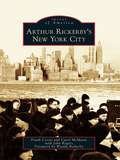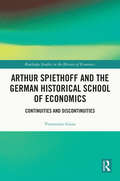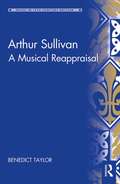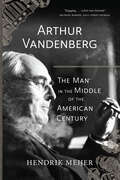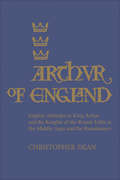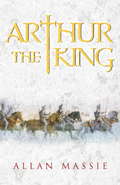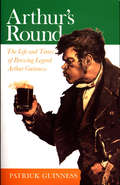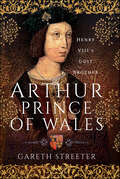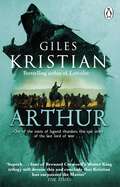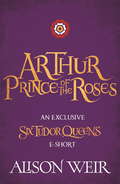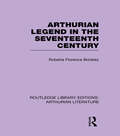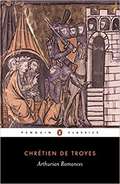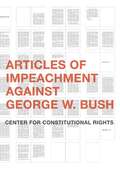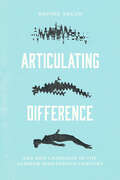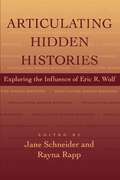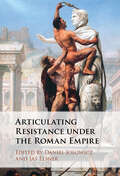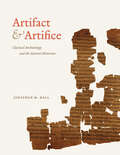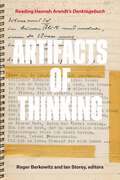- Table View
- List View
Arthur Rickerby's New York City
by Frank Ceresi Wanda Rickerby John Rogerts Carol McmainsArthur Rickerby's illustrious career was spent capturing scores of the nation's significant historical events on film, from the Japanese signing of the Articles of Surrender aboard the USS Missouri in 1945, ending World War II, to famous sports images such as Don Larsen throwing the final pitch of baseball's only World Series perfect game for the New York Yankees in 1956. Today few people know of Arthur Rickerby, the New York born and bred photographer. Arthur Rickerby's New York City not only reintroduces the world-class photojournalist and pays tribute to his outstanding work, but it also features rare and previously unseen New York images that perfectly capture the enduring Rickerby touch.
Arthur Spiethoff and the German Historical School of Economics: Continuities and Discontinuities (Routledge Studies in the History of Economics)
by Vitantonio GioiaArthur Spiethoff (1873–1957), an economist of the German Historical School of Economics, is best known for his theory of the business cycle. Despite Spiethoff calling for a unified reading of his work, his epistemological thinking has received less attention. This book addresses that gap by analysing Spiethoff’s theory of the business cycle in the light of his epistemological views. Putting Spiethoff’s work in context, the book also investigates the most significant features of the evolution of the “research programme” of the German Historical School of Economics, with particular reference to the relationships between Schmoller, Sombart, Weber and Spiethoff. In addition, Spiethoff’s work is compared with some of the scientific orientations of the current debates: on the epistemological side, the book examines the relationship between Spiethoff’s views and some contemporary thinking on scientific realism, as well as methodological pluralism in social sciences. And, more broadly, it emphasises the analytical relevance of the historical approach in explaining the economic imbalances of contemporary capitalism, questioning the idea, widespread in the neoclassical approach, that taking historical specificities into account makes it hard to achieve a theoretically effective attitude. This book is a significant addition to the literature on the German Historical School of Economics and the history of economic thought, business cycle theory and macroeconomics more broadly.
Arthur Sullivan: A Musical Reappraisal (Music in Nineteenth-Century Britain)
by Benedict TaylorArthur Sullivan (1842–1900) was Victorian Britain’s most celebrated and popular composer, whose music to this day reaches a wider audience than that of any of his contemporaries. Yet the comic operas on which Sullivan’s reputation is chiefly based have been consistently belittled or ignored by the British musicological establishment, while his serious works have until recently remained virtually unknown. The time is thus long overdue for scholarly re-engagement with Sullivan. The present book offers a new appraisal of the music of this most notable nineteenth-century British composer, combining close analytical attention to his music with critical consideration of the wider aesthetic and social context to his work. Focusing on key pieces in all the major genres in which Sullivan composed, it includes accounts of his most important serious works – the music to The Tempest, the ‘Irish’ Symphony, The Golden Legend, Ivanhoe – alongside detailed examination of the celebrated comic operas created with W.S. Gilbert to present a balanced portrayal of Sullivan’s musical achievement.
Arthur Vandenberg: The Man in the Middle of the American Century
by Hendrik MeijerThe idea that a Senator—Republican or Democrat—would put the greater good of the country ahead of party seems nearly impossible to imagine in our current climate of gridlock and divisiveness. But this hasn’t always been the case. Arthur H. Vandenberg (1884–1951), Republican from Grand Rapids, Michigan, was the model of a consensus builder, and the coalitions he spearheaded continue to form the foundation of American foreign and domestic policy today. Edward R. Murrow called him “the central pivot of the entire era,” yet, despite his significance, Vandenberg has never received the full public attention he is due—until now. With this authoritative biography, Hendrik Meijer reveals how Vandenberg built and nurtured the bipartisan consensus that created the American Century. Originally the editor and publisher of the Grand Rapids Herald, Vandenberg was appointed and later elected to the Senate in 1928, where he became an outspoken opponent of the New Deal and a leader among the isolationists who resisted FDR’s efforts to aid European allies at the onset of World War II. But Vandenberg soon recognized the need for unity at the dawn of a new world order; and as a Republican leader, he worked closely with Democratic administrations to build the strong bipartisan consensus that established the Marshall Plan, the United Nations, and NATO. Vandenberg, as Meijer reveals, was instrumental in organizing Congressional support for these monumental twentieth-century foreign policy decisions. Vandenberg’s life and career offer powerful lessons for today, and Meijer has given us a story that suggests an antidote to our current democratic challenges. After reading this poignant biography, many will ask: Where is the Vandenberg of today?
Arthur and the Lost Kingdoms
by Alistair MoffatA &“fascinating historical detective work&” that pins down the real story of the legendary medieval king and the court of Camelot (Spectator). The Holy Grail, the kingdom of Camelot, the Knights of the Round Table, and the magical sword Excalibur are all key ingredients of the legends surrounding King Arthur. But who was he really, where did he come from, and how much of what we read about him in stories that date back to the Dark Ages is true? So far, historians have failed to show that King Arthur really existed at all, and for a good reason—they have been looking in the wrong place. In this &“vivid and thought-provoking&” book, Alistair Moffat shatters all existing assumptions about Britain&’s most enigmatic hero (Birmingham Evening Mail). With references to literary sources and historical documents, as well as archeology and the ancient names of rivers, hills, and forts, he strips away a thousand years of myth to unveil the real King Arthur. And in doing so, he solves one of the greatest riddles of them all—the site of Camelot itself. &“A virtuoso performance.&” —Cardiff Western Mail &“Crammed with detail and follows a broad sweep across much of our history from the Ice Age to the Middle Ages.&” —The Scotsman
Arthur of England: English Attitudes to King Arthur and the Knights of the Round Table in the Middle Ages and the Renaissance
by Christopher DeanToday, popular imagination peoples the Middle Ages with damsels in distress and knights riding to their rescue. Of such knights, King Arthur and his companions are the most celebrated. It is certainly true that this is the time when the Arthurian story took shape and Arthurian literature flourished, and that most medieval historians included him in their histories of Britain, though some did so with a considerable degree of scepticism. But how widely was this literature known in its own day? How much credence did people generally place in this king who supposedly once ruled England? To answer these questions, Christopher Dean looks at medieval and Renaissance Arthurian literature in detail, and also examines contemporary chronicles and histories, chivalric theory and practice, popular myths and legends, folk-lore and place-names. The result is to show dramatically that Arthur was not at all as well known as popular belief today fancies. As a historical figure he was early discredited; had it not been for his artificial revival by the Tudor monarchy and the furor caused by the attack upon him by the 'foreigner' Polydore Vergil, which incensed many patriotic Englishmen, his credibility might have disappeared much sooner than it did. Except for Malory's work, medieval Arthurian literature, which often exists in no more than single manuscripts, did not have large audiences. And after 1500, only Edmund Spenser and Thomas Hughes attempted to write seriously on Arthurian themes. Among the ordinary citizens of England, Arthur was hardly known at all, any popular knowledge of him being almost entirely restricted to Wales, Devon, and Cornwall. Elsewhere in Britain the much more familiar figure was Robin Hood. For all the strength of the Arthurian legend as the ultimate medieval knight, he is essentially a modern hero.
Arthur the King: A Romance
by Allan MassieA thrilling and highly original retelling of the Arthurian legend with a twist!It is the aftermath of the Roman occupation of Britain. Kings are now jockeying for position, for title, for land and for power. A young boy confounds the most famous knights of the realm when he pulls a jewelled sword from a cleft in a stone and claims the throne left vacant by the death of Uther Pendragon.In this new vision of the Arthurian story, Camelot is set on the River Tweed and Merlin who disapproves of his knights' yearning for battle and their quest for the Holy Grail. With great humour and energy, Massie has created a bold and original new tale from the stuff of legend.
Arthur's Amazing Armor
by Liz HuyckOff to battle? You'll want to invest in some armor! Learn about the different kinds of armor used throughout the ages in different cultures.
Arthur's Round: The Life and Times of Brewing Legend Arthur Guinness
by Patrick GuinnessIreland's best-known Irishman, his name and signature in every household and village in Ireland, and many abroad, is also the least known. Part of Dublin life for over two centuries, both family and brewery have passed into legend, but their origins have been obscured. Here, in the round, these origins are explored and the story of the man and his background told for the first time. Various sources are examined and myths about Arthur laid to rest, many of which were allowed to continue by his descendants. This narrative traces the family's origins in Ulster, Gaelic and Protestant-Irish tenant-farmers from humble backgrounds on both sides, when Arthur's father Richard appears as a household agent in Celbridge, Co. Kildare, in 1722 to work for Arthur Price, the Protestant Dean of Kildare. In 1755 Arthur takes on a brewery in Leixlip and joins the Kildare Friendly Brothers dining club in 1758, marrying and moving to St James's Gate in 1759/60 where the business developed. By 1781 he is a patriarch and member of liberal 'patriot' political groups, diversifying his assets to preserve his wealth in unsettled times. Of a generation with Edmund Burke and Richard Brinsley Sheridan, this wily businessman built an empire that endured and expanded. Family and social history combine with an account of the brewing process and descriptions of economic and political backgrounds in a rapidly developing Ireland, giving a rich weave to this tapestry. Visual sources include maps, rare original documents, prints, and photographs of associated houses and places, people, and artifacts. The result is a fascinating contextual portrait of an enigmatic figure, the founding father of one of Ireland's most powerful dynasties.
Arthur, Prince of Wales: Henry VIII’s Lost Brother
by Gareth StreeterFor too long, Arthur Tudor has been remembered only for what he never became. The boy who died prematurely and paved the way for the revolutionary reign of his younger brother, Henry VIII. Yet, during his short life, Arthur was at the center of one of the most tumultuous periods of England’s history. At the time of his birth, he represented his father’s hopes for a dynasty and England’s greatest chance of peace. As he grew, he witnessed feuds, survived rebellion and became the focal point of an international alliance. From the threat of pretenders to West Country rebellions, the dramatic twists and turns of early Tudor England preoccupied Arthur’s thoughts. At a young age, he was dispatched to the Welsh border, becoming a figure head for a robust regional government. While never old enough to exercise full power in his dominion, he emerged as a figure of influence, beseeched by petitioners and consulted by courtiers. While the extent of his personal influence can only be guessed at, the sources that survive reveal a determined prince that came tantalizingly close to forging his future. Finally, after years of negotiation, delay and frustration, the prince finally came face to face with his Spanish bride, Katharine of Aragon. The young couple had shared a destiny since the cradle. Securing the hand of this prestigious pride for his son had been a center piece of Henry VII’s foreign policy. Yet, despite being 14 years in the making, the couple were to enjoy just five months together before Arthur succumbed to a mysterious illness. Arthur’s death at the age of 15 was not just a personal tragedy for his parents. It changed the course of the future and deprived England of one of the most educated and cultivated princes in their history. Arthur would never wear the crown the of England. But few Princes of Wales had been better prepared to rule. Arthur, Prince of Wales: Henry VIII’s Lost Brother shows that Arthur Tudor was more than a prince who died. He was a boy that really lived.
Arthur: A gripping, must-read retelling of the legend from the Sunday Times bestselling author of Lancelot
by Giles KristianAntonia Senior in The Times said:'Superb . . . authentic and terrifying . . . fans of Bernard Cornwell’s Winter King trilogy will devour this and conclude that Kristian has surpassed the Master.'And readers are loving ARTHUR . . .'By far the best Arthurian story I have had the honour to read.’ *****‘Brilliant writing, excellent characterization, and immersive storytelling.’ *****‘I've adored this trilogy. The best re-telling of Arthur's legend I've read, and I'd include Cornwell's in that.’ *****‘The ending is bloody and glorious, and very well done. One last thunder of hooves, one last trill of the trumpets. I'm just gutted it's over, I could have read on and on.’ *****‘Enough originality and sheer writing talent to make it a literary must.’ *****‘This is proper storytelling that does not let down those characters of legend.’ *****Years have passed since the clash of shield-walls echoed across the land . . .The Saxons are now the lords of Britain. And yet the bards still sing of Arthur - 'In our darkest time, when we need him most, shall he come again.'Ageing mercenary Beran has no love of bards' songs. Nor of people. Unless they are paying him to steal or kill. Now he has been ordered to murder a boy. But this is no ordinary child. The son of King Constantine and the grandson of High King Ambrosius, this boy could be the saviour of Britain . . . if he lives.Betraying his companions and returning to a world he believed he'd forsaken, Beran vows to take the boy to the one place that still holds out against the invader: Camelot.Hunted by Saxons, Queen Morgana and those he deceived, he will seek the help of Guivret, called the Little King, and the Saracen, Palamedes who once rode beneath Arthur's banner. They will meet the doomed lovers, Tristan and Isolde. And they will fight for their lives and for each other.For if there's to be any hope for Britain, Beran must deliver the boy to Camelot. And to do that, he must come to terms with his past . . .Arthur is the breathtaking new novel from the author of the bestselling Lancelot, hailed 'a masterpiece' by Conn Iggulden.
Arthur: Prince of the Roses
by Alison WeirArthur: Prince of the Roses by bestselling historian Alison Weir is an e-short and companion piece to her stunning novel, Katherine of Aragon, the first in a spellbinding six-novel series about Henry VIII's Queens. Fans of Philippa Gregory and Elizabeth Chadwick will love this insight into the story of this ill-fated Tudor prince. 'You are the first prince of my line, the Tudor line.' Arthur, the first Tudor prince, is raised to believe that he will inherit a kingdom destined to be his through an ancient royal bloodline. He is the second Arthur, named for the legendary hero-king of Camelot. To be a worthy ruler, he must excel at everything - and show no weakness. But Arthur is not strong, and the hopes of England weigh heavy on his slight shoulders. And, all the while, his little brother Harry, the favoured, golden son, is waiting in the wings.Praise for Alison Weir and Katherine of Aragon: 'A tender understanding of and genuine sympathy for this proud, much-loved and honourable Queen. . . I was gripped [from] start to finish' Mavis Cheek'Well-researched and engrossing' Good Housekeeping'Yet again, Alison Weir has managed to intertwine profound historical knowledge with huge emotional intelligence, to compose a work that throws light on an endlessly fascinating historical figure. Yet her real gift in all of this is making it feel so fresh and alive' Earl Spencer'This exquisite book charts the rise and fall of Henry VIII's first wife, Katherine. . . A fascinating insight into this period of our history. Weir's undeniable strength is her immaculate description, enabling the reader to be transported back to Tudor England' Sun'Weir manages to untangle the complex web of 16th-century politics, shown through Katherine's duties as ambassador, and her astute reading of the games being played. This adds greatly to the heft of the character, demonstrating what a competent woman she was becoming' Herald Scotland'Katherine of Aragon, The True Queen is a true tour de force. Finely crafted, this novel is wonderful historical fiction and an outstanding introduction to the Six Tudor Queens series' Queen Anne Boleyn Blog'Known for bestselling historical biographies, Alison Weir is in command of her detail . . . her handling of Katherine's misery and dignified response to her predicament is very touching' Elizabeth Buchan, Daily Mail
Arthurdale
by Inc. Arthurdale Heritage Amanda Griffith PenixIn August 1933, Eleanor Roosevelt visited the impoverished coal communities of north central West Virginia. Suffering from the effects of the Great Depression, these coal families looked to the First Lady for help out of the devastating economic times. Her visit spurred the creation of Arthurdale, the nation's first New Deal Homestead Community. Arthurdale quickly became known as "Eleanor's Little Village" because of the First Lady's involvement with the project. She visited the community often to dine, dance, and converse with the homesteaders and to attend high school graduations. In addition to the creation of new housing, Arthurdale featured a community business center, state-of-the-art school buildings, a craft industry, an industrial factory, and home-based agricultural production. Although not a financial triumph for the federal government, the social success of the community is immeasurable.
Arthurian Drama: An Anthology (Routledge Library Editions: Arthurian Literature)
by Alan LupackThis anthology reproduces six plays based on stories of King Arthur from a variety of periods. Originally published in 1991, it offers a comprehensive discussion of Arthurian Drama in introduction and also provides an appendix listing printed scripts in English that address Arthurian legend.
Arthurian Legend in the Seventeenth Century (Routledge Library Editions: Arthurian Literature)
by Roberta Florence BrinkleyThe study of the Arthurian legend in the 1600s has revealed almost no romance; the stories are more about the truth of Arthur’s existence and his exploits, with influence due to political bearing of the royalty versus parliament at the time. This fascinating study elucidates the differences between the stories of the seventeenth century and those more well-known now and looks at the development of the literature in line with the political climate and its links with Arthurian prophecy and lineage. Originally published 1932 and again in 1967.
Arthurian Romances
by Chrétien De Troyes William W. Kibler Carleton W. Carroll<p>Although he didn't invent the Round Table or the tales of its fellowship, the twelfth-century poet Chrétien de Troyes was the first to recount in verse the adventures of Arthur's knights. He is also chiefly responsible for establishing the importance of the Arthurian legend in European literature and assuring its survival into modern times. This sensitive translation of Chrétien's verse narratives features four romances, including those of Erec and Enide, Cligés, Yvain, and Lancelot. <p>Erec and Enide's tale illustrates how honor can be restored to a troubled relationship through acts of public duty. Cligés' tale involves a forbidden relationship, in which a knight falls in love with his queen—who is also his uncle's wife. The story of Yvain explores the effects of long-term absence on a questing knight's marriage. Lancelot's adventure, the rescue of Guinevere, is Chrétien's enduring contribution to the tradition of Arthurian myth. The version included is a principal source of Mallory's popular Le Morte d'Arthur. Lively and accessible, these four romances form the most complete expression of the ideals of French chivalry by a single author.</p>
Arthurian Romances
by Chrétien de TroyesTaking the legends surrounding King Arthur and weaving in new psychological elements of personal desire and courtly manner, Chrétien de Troyes fashioned a new form of medieval Romance. The Knight of the Cart is the first telling of the adulterous relationship between Lancelot and Arthur's Queen Guinevere, and in The Knight with the Lion Yvain neglects his bride in his quest for greater glory. Erec and Enide explores a knight's conflict between love and honour, Cligés exalts the possibility of pure love outside marriage, while the haunting The Story of the Grail chronicles the legendary quest. Rich in symbolism, these evocative tales combine closely observed detail with fantastic adventure to create a compelling world that profoundly influenced Malory, and are the basis of the Arthurian legends we know today.
Articles of Impeachment Against George W. Bush
by Center For Constitutional Rightssets out the legal arguments for impeachment. Also includes relevant laws and legal precedents
Articles of War (Stackpole Classics)
by Albert S. CastelThe American Civil War is filled with fascinating characters. This collection of biographical essays on the &“winners and losers&” of the Civil War covers some of the most intriguing: Ulysses S. Grant, George B. McClellan, Sam Houston, Albert Sidney Johnston, Nathan Bedford Forrest, and William Clarke Quantrill, to name just a few.In Articles of War you&’ll discover:Some WinnersUlysses S. Grant, whose brilliant Vicksburg Campaign was a model of military strategyJohn A. &“Black Jack&” Logan, one of the war&’s few successful political generalsNathan Bedford Forrest, a natural military genius despite his &“Lost Cause&”Some LosersGeorge B. McClellan, whose lack of eagerness cost the Union two opportunities to win the warEarl Van Dorn, a victim of sheer bad luckTheophilus H. Holmes, the little-known incompetent, called &“granny Holmes&” by his own menSome Winners Who Became LosersAlbert Sidney Johnston, the Confederacy&’s &“General Who Might Have Been&”Leonidas Polk, whose initial good luck eventually ran outWilliam Clarke Quantrill, a winner in death but a loser in lifeAnd Some Losers Who Became WinnersSam Houston, who, had he lived longer, could have been a winner in TexasWilliam Tecumseh Sherman, an exceptional man; a capable, but flawed, commander
Articulating Difference: Sex and Language in the German Nineteenth Century
by Sophie SalvoEnriches contemporary debates about gender and language by probing the histories of the philosophy and sciences of language. Drawing on a wide range of texts, from understudied ethnographic and scientific works to canonical literature and philosophy, Sophie Salvo uncovers the prehistory of the inextricability of gender and language. Taking German discourses on language as her focus, she argues that we are not the inventors but, rather, the inheritors and adapters of the notion that gender and language are interrelated. Particularly during the long nineteenth century, ideas about sexual differences shaped how language was understood, classified, and analyzed. As Salvo explains, philosophers asserted the patriarchal origins of language, linguists investigated “women’s languages” and grammatical gender, and literary Modernists imagined “feminine” sign systems, and in doing so they not only deemed sex-based divisions to be necessary categories of language but also produced a plethora of gendered tropes and fictions, which they used both to support their claims and delimit their disciplines. Articulating Difference charts new territory, revealing how gendered conceptions of language make possible the misogynistic logic of exclusion that underlies arguments claiming, for example, that women cannot be great orators or writers. While Salvo focuses on how male scholars aligned language study with masculinity, she also uncovers how women responded, highlighting the contributions of understudied nineteenth-century works on language that women wrote even as they were excluded from academic opportunities.
Articulating Hidden Histories: Exploring the Influence of Eric R. Wolf
by Jane Schneider Rayna RappWith his groundbreaking Europe and the People Without History, Eric R. Wolf powerfully advanced the project of integrating the disciplines of anthropology and history. In Articulating Hidden Histories, many of those influenced by Wolf—both anthropologists and historians—acknowledge the contribution of this great scholar while extending his work by presenting their own original field and archival research.The "hidden histories" referred to here encompass the histories of economic and political forces capable of dislodging people from their surroundings, of the people thus dislocated, and of the anthropological concepts developed to understand such processes. Within this framework, the contributors explore an extraordinarily wide range of topics, from the invention of tribalism in colonial West Africa to the ecological activism of North American housewives.This collection offers a fitting tribute not only to Eric Wolf's work, but to its continuing influence on the fields of anthropology and history.
Articulating Resistance under the Roman Empire
by Jaś Elsner Daniel JolowiczThis book explores the many strategies by which elite Greeks and Romans resisted the cultural and political hegemony of the Roman Empire in ways that avoided direct confrontation or simple warfare. By resistance is meant a range of responses including 'opposition', 'subversion', 'antagonism', 'dissent', and 'criticism' within a multiplicity of cultural forms from identity-assertion to polemic. Although largely focused on literary culture, its implications can be extended to the world of visual and material culture. Within the volume a distinguished group of scholars explores topics such as the affirmation of identity via language choice in epigraphy; the use of genre (dialogue, declamation, biography, the novel) to express resistant positions; identity negotiation in the scintillating and often satirical Greek essays of Lucian; and the place of religion in resisting hegemonic power.
Articulations of Nature and Politics in Plato and Hegel
by Vicky RoupaThis book examines nature as a foundational concept for political and constitutional theory, drawing on readings from Plato and Hegel to counter the view that optimal political arrangements are determined by nature. Focussing on the dialectical implications of the word ‘nature’, i.e. how it encompasses a range of meanings stretching up to the opposites of sensuousness and ideality, the book explores the various junctures at which nature and politics interlock in the philosophies of Plato and Hegel. Appearance and essence, inner life and public realm, the psychical and the political are all shown to be parts of a conflictual structure that requires both infinite proximity and irreducible distance. The book offers innovative interpretations of a number of key texts by Plato and Hegel to highlight the metaphysical and political implications of nature’s dialectical structure, and re-appraises their thinking of nature in a way that both respects and goes beyond their intentions.
Artifact & Artifice: Classical Archaeology and the Ancient Historian
by Jonathan M. HallIs it possible to trace the footprints of the historical Sokrates in Athens? Was there really an individual named Romulus, and if so, when did he found Rome? Is the tomb beneath the high altar of St. Peter’s Basilica home to the apostle Peter? To answer these questions, we need both dirt and words—that is, archaeology and history. Bringing the two fields into conversation, Artifact and Artifice offers an exciting excursion into the relationship between ancient history and archaeology and reveals the possibilities and limitations of using archaeological evidence in writing about the past. Jonathan M. Hall employs a series of well-known cases to investigate how historians may ignore or minimize material evidence that contributes to our knowledge of antiquity unless it correlates with information gleaned from texts. Dismantling the myth that archaeological evidence cannot impart information on its own, he illuminates the methodological and political principles at stake in using such evidence and describes how the disciplines of history and classical archaeology may be enlisted to work together. He also provides a brief sketch of how the discipline of classical archaeology evolved and considers its present and future role in historical approaches to antiquity. Written in clear prose and packed with maps, photos, and drawings, Artifact and Artifice will be an essential book for undergraduates in the humanities.
Artifacts of Thinking: Reading Hannah Arendt's Denktagebuch
by Roger Berkowitz and Ian StoreyArtifacts of Thinking: Reading Arendt’s “Denktagebuch” offers a path through Hannah Arendt’s recently published Denktagebuch, or “Book of Thoughts.” In this book a number of innovative Arendt scholars come together to ask how we should think about these remarkable writings in the context of Arendt’s published writing and broader political thinking.Unique in its form, the Denktagebuch offers brilliant insights into Arendt’s practice of thinking and writing. Artifacts of Thinking provides an introduction to the Denktagebuch as well as a glimpse of these fascinating but untranslated fragments that reveal not only Arendt’s understanding of “the life of the mind” but her true lived experience of it.
